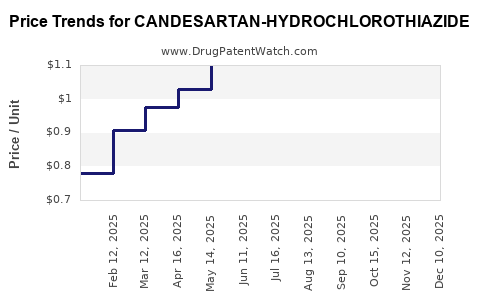Drug Price Trends for CANDESARTAN-HYDROCHLOROTHIAZIDE
✉ Email this page to a colleague

Average Pharmacy Cost for CANDESARTAN-HYDROCHLOROTHIAZIDE
| Drug Name | NDC | Price/Unit ($) | Unit | Date |
|---|---|---|---|---|
| CANDESARTAN-HYDROCHLOROTHIAZIDE 16-12.5 MG TB | 43547-0459-09 | 0.65024 | EACH | 2024-11-20 |
| CANDESARTAN-HYDROCHLOROTHIAZIDE 16-12.5 MG TB | 62559-0660-90 | 0.65024 | EACH | 2024-11-20 |
| CANDESARTAN-HYDROCHLOROTHIAZIDE 16-12.5 MG TB | 33342-0131-15 | 0.65024 | EACH | 2024-11-20 |
| CANDESARTAN-HYDROCHLOROTHIAZIDE 32-12.5 MG TB | 00378-3002-77 | 0.78880 | EACH | 2024-11-20 |
| CANDESARTAN-HYDROCHLOROTHIAZIDE 16-12.5 MG TB | 00378-3001-77 | 0.65024 | EACH | 2024-11-20 |
| CANDESARTAN-HYDROCHLOROTHIAZIDE 32-25 MG TAB | 62559-0662-90 | 0.98570 | EACH | 2024-11-20 |
| >Drug Name | >NDC | >Price/Unit ($) | >Unit | >Date |


